电子教案Unit 1
- 格式:doc
- 大小:119.50 KB
- 文档页数:8
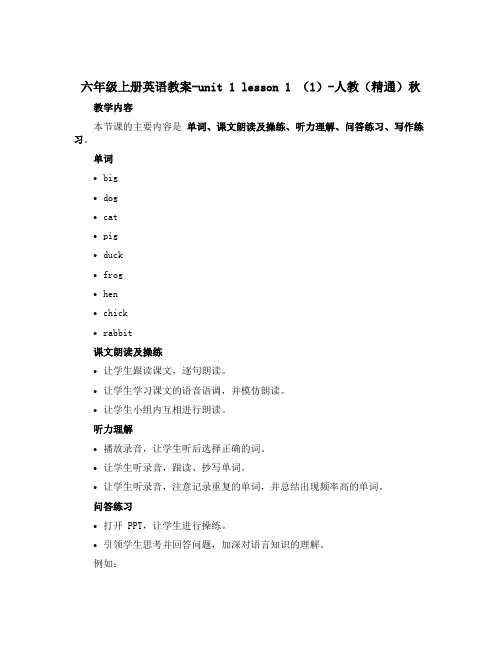
六年级上册英语教案-unit 1 lesson 1 (1)-人教(精通)秋教学内容本节课的主要内容是单词、课文朗读及操练、听力理解、问答练习、写作练习。
单词•big•dog•cat•pig•duck•frog•hen•chick•rabbit课文朗读及操练•让学生跟读课文,逐句朗读。
•让学生学习课文的语音语调,并模仿朗读。
•让学生小组内互相进行朗读。
听力理解•播放录音,让学生听后选择正确的词。
•让学生听录音,跟读、抄写单词。
•让学生听录音,注意记录重复的单词,并总结出现频率高的单词。
问答练习•打开 PPT,让学生进行操练。
•引领学生思考并回答问题,加深对语言知识的理解。
例如:Q: What’s this?A: It’s a rabbit.Q: What’s that?A: It’s a frog.写作练习在板书上呈现图片,让学生用单词进行描述,并将描述写在黑板上。
例如:•图片上是一只大猪。
•图片上有两只小鸡。
教学目标1.学生能正确听、说、读、写 lesson 1 的单词。
2.学生能流畅地朗读 lesson 1 的课文,并理解其中的语音、语调。
3.学生能听懂 lesson 1 的录音,并选择正确的单词。
4.学生能听懂问题,并用所学单词进行回答。
5.学生能用英语描述图片中的内容。
教学重难点•教学重点:课文朗读及操练、听力理解、问答练习、写作练习。
•教学难点:课文朗读及操练、听力理解、问答练习。
教学准备•教学 PPT。
•学生课本。
•录音笔及录音资料。
教学步骤1. 导入新课通过学生自然科学的知识引入本节课内容,激发学生学习英语的兴趣。
2. 学生自主学习让学生先进行自主学习,听录音、看课本、认真朗读课文。
3. 小组练习让学生分成小组,相互进行单词朗读及问答练习。
4. 教师指导操练通过 PPT 演示课文,引导学生进行语音语调的学习。
5. 练习总结进行总体练习,让学生复习所学内容。
6. 作业布置布置课后的习题作业。
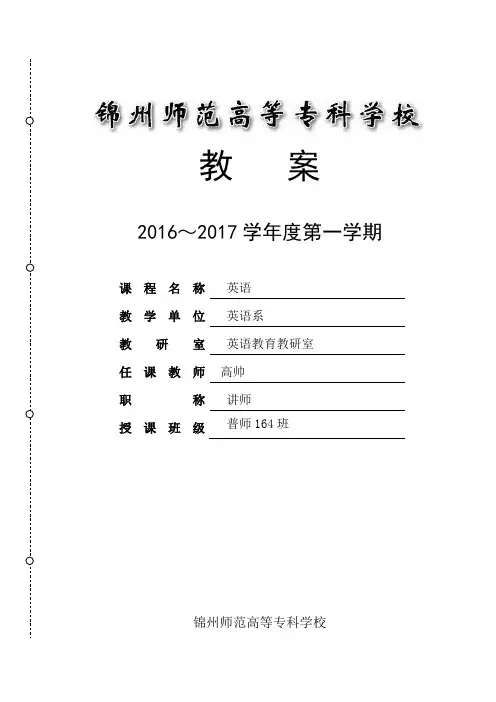
2016~2017学年度第一学期课程名称英语教学单位英语系教研室英语教育教研室任课教师高帅职称讲师授课班级普师164班锦州师范高等专科学校2016~2017学年度第一学期授课课程:英语授课教师:高帅章节Book I UNIT 1 High school vs college授课班级普师164班授课时间Week1-3 授课类型Theory and practice学时数4学时教学目标知识目标:To master the new words, expressions, structures and plots.能力目标:To use them in actual situations.德育目标:To cultivate the students' interest in the reading.教学重点和难点1. Key words and phrases.2. Translation and difficult structures.教学(具)准备PPT; MP3; Reference book ; Textbook教学方法Teaching, discussion, elicitation and exercising methods教学主要内容Unit 1 Reading1. Brief introduction to the text.2. Discussion3. Practice reading the new words by imitating the mp3.4. Detailed study of the text, including, lexical item and vocabulary etc.5. Exercises of Unit One6. Translation of some key words and expressions7. Teaching summary, including language points and the instructive significance of the text in students’ future study and life.8. Homework. Different homework should be done after each class, such as word formation and doing all the exercises.教学过程设计备注Unit 1 Passage A High school vs collegeStep One: Introduction, Background information, DiscussionStep Two: Detailed study of the textStep Three: ExercisesStep Four: Teaching summaryStep Five: HomeworkStep One: Introduction, Background information, DiscussionThe top ten universities in the worldThey are University of Cambridge,University of Oxford,Harvard University,University of California,Berkeley,Massachusetts Institute of Technology,Stanford University (USA),University of Tokyo,Princeton University(USA),California Institute of Technology and Imperial College of London.Here we only briefly introduce the first five universities to you.A.University of CambridgeBritain's University of Cambridge has topped the list,making it the best university in the world for science.In 2009,the university will celebrate its 800th anniversary,making it one of the world's oldest universities.Cambridge is the largest university in the United Kingdom(over 100 departments,faculties and schools).Its contribution to the world has ranged from the discovery of the mechanism of blood circulation to the structure of DNA,from the great philosophers of the early 15th century to the groundbreaking work of its many Nobel Prize winners (more than 60 distinguished names feature on the list).B.University of OxfordThe University of Oxford is one of the oldest English-speaking universities.It can lay claim to nine centuries of documented existence.According to the university's website,there is no clear date of foundation,but teaching existed at Oxford in some form in 1096 and developed rapidly from 1167,when Henry II banned English students from attending the University of Paris.Except for St. Hildas—which continues to remain an all-women college—all of Oxford's 39 colleges now admit both men and women.C.Harvard UniversityHarvard University is ranked No.3 among the top ten universities in the world.Harvard College was established in 1636 and was named for its first benefactor(捐助者)John Harvard of Charlestown.Harvard was a young minister who,on his death in 1638,left his library and half his estate to the newly established institution.It is the oldest institution of higher learning in the United States.Seven presidents of the United States (John Adams,John Quincy Adams,Theodore and Franklin Delano Roosevelt,Rutherford B Hayes,John Fitzgerald Kennedy and George W Bush)were graduates of Harvard.Its faculty has produced 40 Nobel laureates (戴桂冠的人).D.University of California,BerkeleyThe roots of the University of California go back to the gold rush days of 1849,when the 谈话法讨论法读书指导法drafters of the states constitution required the legislature to encourage by all suitable means the promotion of intellectual,scientific,moral and agricultural improvement of the people of California.The university that was born nearly 20 years later—on March 23,1868—was the product of a merger between the College of California(a private institution)and the Agricultural,Mining,and Mechanical Arts College.Among other things,the university is credited with the isolation of the human polio virus andthe discovery of all artificial elements heavier than uranium.Eighteen members of the Berkeley faculty have been awarded Nobel Prizes for these and subsequent discoveries,as well as in literature and economics.E.Massachusetts Institute of TechnologyIt's probably one of the most famous universities in the world.But did you know its founder,William Barton Rogers,apparently never received a degree?In 1853,he moved to Boston,where he enlisted the support of the scientific community to create an institution for technical and scientific education.It was largely through his efforts that the Massachusetts Institute of Technology was born in 1861.Today,the Institute has more than 900 faculty and 10,000 undergraduate and graduate students.It is organized into five Schools—Architecture and Planning,Engineering,Humanities,Arts and Social Sciences,Management and Science—and the Whitaker College of Health Sciences and Technology.Fifty-nine current or former members of the MIT community have won the Nobel Prize.The U.S. News & World Report ranks MIT—along with Stanford University and Duke University—at No.5 in its rating for America's best universities for the year 2005.F.Stanford University (USA)略G.University of Tokyo略H.Princeton University (USA)略I.California Institute of Technology略J.Imperial College of London略SAT(Scholastic Assessment Test)SAT(Scholastic Assessment Test)(“学术水平测验考试”是美国高中生进入美国大学的标准入学考试)The College Board's SAT Program consists of the SAT Reasoning Test TM(SAT)and SAT Subject Tests TM.The SAT is three hours and 45 minutes long and measures skills in three areas: critical reading,math,and writing.Although most questions are multiple choice,students are also required to write a 25-minute essay.The SAT Subject Tests are one-hour,mostly multiple-choice tests in specific subjects.These tests measure knowledge of particular subjects and the ability to apply that knowledge.Many colleges require or recommend one or more of these tests for admission or placement purposes.Each section of the SA T is scored on a scale of 200—800,with two writing subscores for multiple-choice and the essay.It is administered seven times a year in the U.S.,Puerto Rico,and U.S.Territories,and six times a year overseas.Many colleges use the Subject Tests for admission,for course placement,and to advise students about course ed in combination with other background information(your high school record,scores from other tests like the SAT Reasoning Test,teacher recommendations,etc.),they provide a dependable measure of your academic achievement and are a good predictor of future performance.Step Two: Detailed study of the textfigure out想出;弄清楚;了解谈话法讨论法读书指导法小组活动法e.g. We must figure out how to solve the problem. 我们必须想出办法解决这个问题。
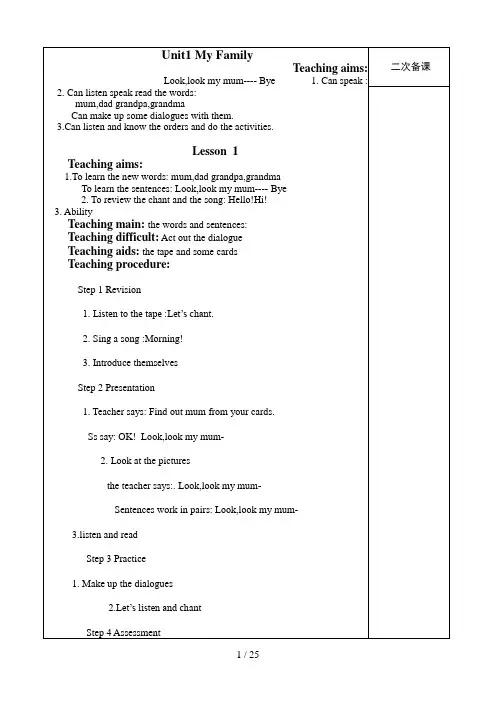

英语基础模块1电子教案-CAL-FENGHAI-(2020YEAR-YICAI)_JINGBIAN英语基础模块1电子教案【篇一:基础模块1电子教案(上)】unit 1 nice to meet you !课程名称:英语使用教材及出版社:《英语基础模块1第2版》高等教育出版社教学课型:技能课课时:共9课时教学目标:语言知识目标:学生能够理解并运用在不同场景下的简单问候语,能够使be动词的一般现在时介绍个人及他人信息。
语言技能目标:听——学生能够听懂在不同场景下的简单问候语。
说——学生能够在不同场景下用简单的问候语问候他人。
读——学生能够读懂名片上的信息。
写——学生能够根据个人情况做出自己的名片。
学习策略:学生学习将事物归类排序的能力。
文化意识:学生掌握中文人名与英文国家人名的不同排序规则。
情感态度:学生了解不同的职业,并初步确定自己的求职意向。
单元任务:学生能运用所学语言拟定自己未来的名片。
教学重点:学生能够理解并运用在不同场景下的简单问候语。
教学难点:学生能够使be动词的一般现在时介绍个人及他人信息。
学情分析:学生处于中职英语学习的第二年,英语基础和技能仍然较薄弱,通过第一年自编教材的学习,口语技能和英语基础知识有一定的训练和提高。
教学方法:活动教学法、任务教学法、情景教学法教学准备:ppt、audio file for listening教学过程:period 1-2:words expressionsstep 1 lead-int greets ss: nice to see you again! last term, we got along well with each other. i hope we can spent a happy term from now on.t help ss read all the new words correctly.step 2 new contentt helps ss have a general idea of the usage of some important words.1. firsta. 第一的,最先的(置于名词之前时,通常与the或one’s连用)eg. the first month of the year 一年的第一个月the first three pages of the book 这本书的前三页it was my first visit to europe. 那是我第一次去欧洲。
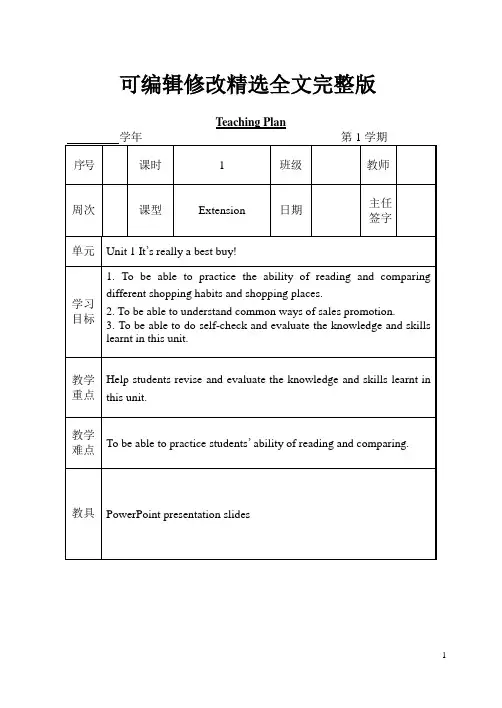
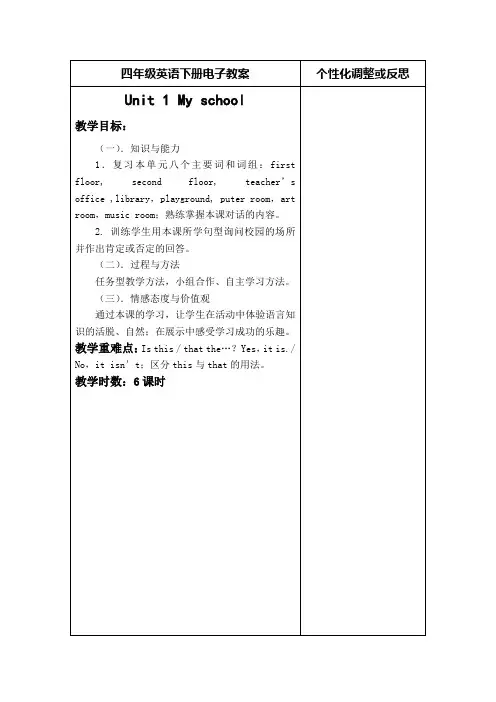
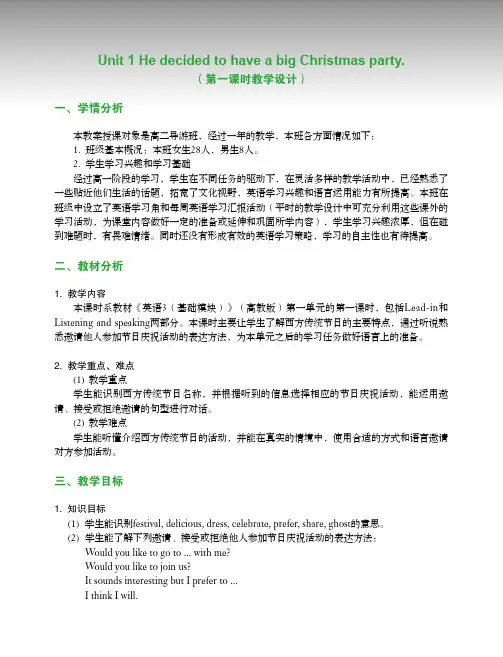
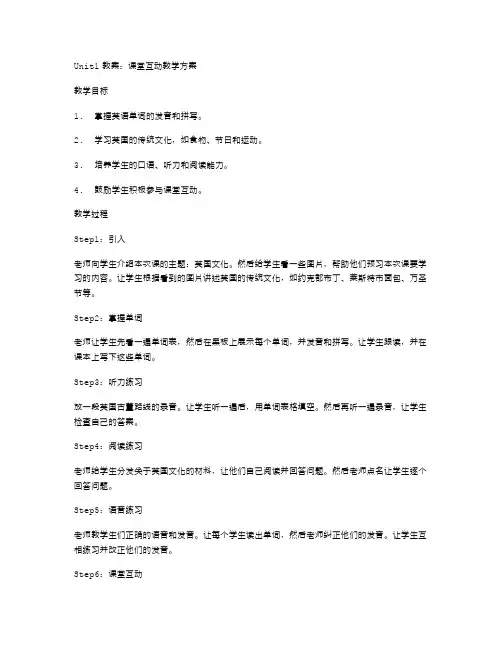
Unit1教案:课堂互动教学方案教学目标1.掌握英语单词的发音和拼写。
2.学习英国的传统文化,如食物、节日和运动。
3.培养学生的口语、听力和阅读能力。
4.鼓励学生积极参与课堂互动。
教学过程Step1:引入老师向学生介绍本次课的主题:英国文化。
然后给学生看一些图片,帮助他们预习本次课要学习的内容。
让学生根据看到的图片讲述英国的传统文化,如约克郡布丁、莱斯特市面包、万圣节等。
Step2:掌握单词老师让学生先看一遍单词表,然后在黑板上展示每个单词,并发音和拼写。
让学生跟读,并在课本上写下这些单词。
Step3:听力练习放一段英国古董路线的录音。
让学生听一遍后,用单词表格填空。
然后再听一遍录音,让学生检查自己的答案。
Step4:阅读练习老师给学生分发关于英国文化的材料,让他们自己阅读并回答问题。
然后老师点名让学生逐个回答问题。
Step5:语音练习老师教学生们正确的语音和发音。
让每个学生读出单词,然后老师纠正他们的发音。
让学生互相练习并改正他们的发音。
Step6:课堂互动分组让学生互相交流,分享他们在英国文化上学习到的东西。
鼓励学生使用他们学到的单词和语言技能,积极参与互动。
Step7:练习老师发放练习册,让学生做题。
这些问题涉及到听力、阅读、语法和单词拼写,帮助学生巩固他们的英语技能。
Step8:评价老师对本课程进行总结。
检查学生是否已经掌握了本单元的目标,并给予他们反馈和建议。
教学效果通过这一教学方案的实施,学生们将获得以下效果:1.在掌握英语单词的发音和拼写方面,取得了重大进展。
2.学习和了解了英国的传统文化。
3.培养了学生的口语、听力和阅读能力。
4.通过课堂互动,鼓励学生积极参与,并提高了他们的英语技巧。
5.获得了更多的自信和积极性。
结论本课程的课堂互动教学方案是非常成功的。
它允许学生充分发挥他们的学习能力,并鼓励他们积极参与课堂。
此外,它还开发和扩展了学生的语言技能,并帮助他们更好地掌握了英语的学习。
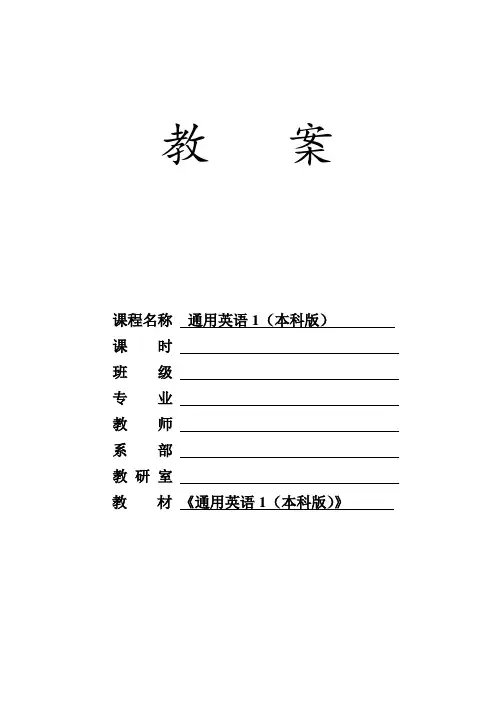
教案课程名称通用英语1(本科版)课时班级专业教师系部教研室教材《通用英语1(本科版)》补充教学资源PART III READING参考译文长大后就离开了你我记不清自己当时多大,只记得当时很困惑。
小女孩嘛,都喜欢小女孩喜欢的那些事情。
但随着自己慢慢长大,我内心开始意识到,长大可能意味着要离开父母。
我和我的决定斗争了好几天。
我内心深处一部分想着留下,而另一部分渴望离开。
无论哪一部分都不愿伤害母亲的感情,可我明白,这终将不可避免。
每天晚上我睡觉的时候,我和妈妈会有一个睡前活动,这个习惯从我很小时就有了。
“抱抱我,像我抱你那样。
”我们相互打趣。
有时,拥抱简简单单;有时,需要一些超出常规的手臂动作,然后另一方必须正确复制。
“亲亲我,像我亲你那样。
”同样,有时候,是在脸颊上轻轻点一点的一个吻,而有时,是以某种特别的方式亲来亲去的吻,而另一方则要认真效仿。
我们这样坚持了多年。
然而,有段时间,我突然不想睡前再拥抱她、亲吻她。
我长大了,我想离开。
但是,该怎样向母亲挑明呢?接连数日,此事一直压在我的心头,直到有天晚上,趁母亲给我盖被子时,我全盘托出,说出了自己的想法。
那样的坦承,痛彻心扉,部分原因是它意味着我的童年时代的一部分结束了,还有部分原因是我知道这注定会伤害她。
但母亲却镇定自若,她理解。
我不知道她事后是否流泪伤心,我认为她可能会的。
因为现在我自己已为人母,终于理解父母看到孩子们长大后那种喜忧参半的复杂感情。
上周,儿子说,他朋友拿我给他午餐盒里塞便条的事来取笑他。
我告诉他,如果他不希望我放便条,我以后就再也不会写那些东西了。
尽管我有过与儿子同样的感受,但我还是突然意识到,他正悄悄离我远去。
虽然他说,我可以继续写便条,但我分明看到了他眼神中的那份挣扎,那是在不想伤害我的感情与他正在长大这一事实之间的挣扎。
长大与远去,可能是由于午餐盒里的便条,也可能是由于睡前的拥抱,还可能是由于他已长大而完全不再需要的别的东西。
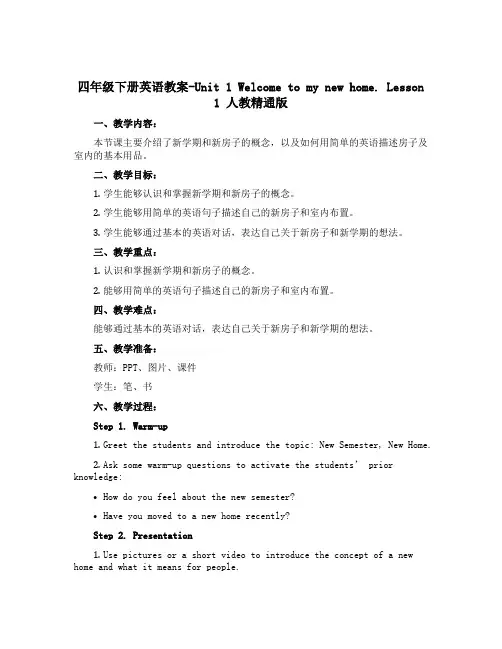
四年级下册英语教案-Unit 1 Welcome to my new home. Lesson1 人教精通版一、教学内容:本节课主要介绍了新学期和新房子的概念,以及如何用简单的英语描述房子及室内的基本用品。
二、教学目标:1.学生能够认识和掌握新学期和新房子的概念。
2.学生能够用简单的英语句子描述自己的新房子和室内布置。
3.学生能够通过基本的英语对话,表达自己关于新房子和新学期的想法。
三、教学重点:1.认识和掌握新学期和新房子的概念。
2.能够用简单的英语句子描述自己的新房子和室内布置。
四、教学难点:能够通过基本的英语对话,表达自己关于新房子和新学期的想法。
五、教学准备:教师:PPT、图片、课件学生:笔、书六、教学过程:Step 1. Warm-up1.Greet the students and introduce the topic: New Semester, New Home.2.Ask some warm-up questions to activate the students’ prior knowledge:•How do you feel about the new semester?•Have you moved to a new home recently?Step 2. Presentatione pictures or a short video to introduce the concept of a new home and what it means for people.2.Introduce key vocabulary related to the topic, such as new home, living room, bedroom, kitchen, bathroom, bed, desk, chair, sofa, TV, etc.3.Present the sentence pattern。
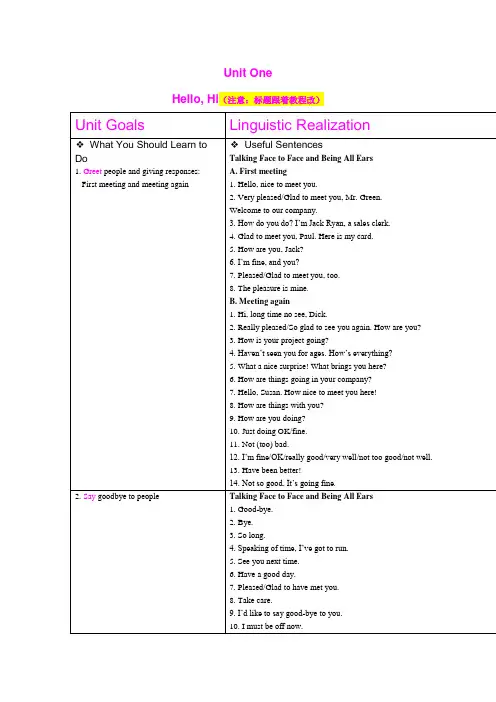
Unit OneHello, Hi(注意:标题跟着教程改)Key and TranslationSECTION I Talking Face to Face Imitating Mini-Talks1Work in pairs. Look at the pictures and practice the following mini-talks for greeting and introducing people.Acting out the Tasks2Work in pairs and act out the tasks by following the above mini-talks.Key for reference:1) Task: Meet Prof. Waters at the airport.A: How do you do, Prof. Waters. I‟m your interpreter(翻译), Li HongB: How do you do? Li Hong. Nice to meet you.A: Welcome to China.B: Thank you for coming to meet me.2) Task: Exchange business cards with Mr. Green.A: Pleased to meet you, Mr. Green. Here is my business card.B: Thank you. Ah, so you are Liu Ming.A: Yes, I‟ll be your tour guideB: It‟s nice to meet you. Here is my card.3) Task: Introduce a foreign friend to your colleague.A: Hello, Lily. This is Mrs. Smith, our new English teacher.B: How do you do, Mrs. Smith? Welcome to our school.C: Thank you. Oh, the campus is beautiful.B: Yes. May I invite you to have a cup of tea together?4) Task: Greet your business partner, Mr. Johnson, at a trade fair.A: Hello, Mr. Johnson. Nice to meet you again at the trade fair.B: Hi, Zhang. How are things with you?A: Fine. We have brought a new product to the fair.B: Great! I‟m eager to see it.5) Take leave and say goodbye to your hostess, Mrs. Waters.A: Hello, Mrs. Waters. We‟ve got to leave now.B: Why so early? I have got some nice tea for you.A: No, thank you. It‟s time we left.B: OK. Then see you tomorrow.Studying Business Cards3Business cards are very useful for introducing people. Now let’s read them and try to use the information in the cards in introductions.匹兹堡州立大学社会语言学系迈克·布林博士校长地址:堪萨斯州匹兹堡市北大街1701号匹兹堡州立大学邮编:KS 66762电话:316-231-2750传真:316-231-2750Following Sample Dialogues4 Read the following sample dialogues and try to perform your own tasks. Putting Language to Use5Imagine you are meeting an English teacher from the USA at the airport. Read aloud the following dialogue with your partner by putting in the missing words.Key: 1. Robert 2. Thank you 3. pleasure 4. Here is 5. this is6. How do you do7. call me8. journey9. the hotel 10. very kind6Imagine you are a new employee at a joint venture. Mr. Smith is the general manager there. You meet him for the first time at the company’s canteen. Fill in the blanks according to the clues given in the brackets. Then act it out with your partner. Key: 1. Excuse me 2. Oh, yes. How do you do, Mr. Smith. I‟m Li Ying.3. Welcome to our company4. you are the general manager5. Here is my card6. Thank you7. My email address is l-i-y-i-n-g@-yahoo-dot-com-dot-cnSECTION II Being All EarsLearning Sentences for Workplace Communication1Listen to 10 sentences for workplace communication cross-referenced with their Chinese translations.Script:1) Hello, nice to meet you. Mrs. Waters.2) Excuse me, are you Mr. Green from England?3) I‟m Jack Green from Canada. Here is my card.4) Glad to meet you, Paul. Here is my card.5) How are you, Jack? Nice to meet you, again.6) Welcome to our college, Dick.7) Hi, long time no see. Do you remember me?8) What a surprise to see you here.9) Oh, it‟s you, President Kong. Nice to see you again.10) My name is Dick Washington. Please call me Dick.2Listen to the following sentences for workplace communication in Column A and match each one with its Chinese version in Column B.Script:1) How are you? Nice to meet you.2) Hello, this is Professor Kong, our president.3) Hi! My name is Peter Green. Glad to meet you.4) Hello, John. So glad to see you again.5) Good morning, Mr. Smith. How are you doing?6) Hi! Jack. Do you still remember me?7) May I introduce my sister to you?8) What a surprise to see you here.9) Welcome to our college. This is my card.10) Are you Mr. Black from America?Key:1-h, 2-j, 3-e, 4-a, 5-g, 6-b, 7-I, 8-c, 9-d, 10-f3 You will hear 6sentences for workplace communication. While listening, you are required to complete the dialogues by ticking the appropriate responses out of the four choices provided. Script1. How do you do?2. Hi, Tom. How are you?3. Hello, Mary, I‟d like you to meet Mark.4. Hello. Let me introduce myself. I am Linda.5. Let me introduce the new professor to you.6. Do you think we‟ve met before?Key:1. A2. A3.D4. C5.A6. DHandling a Dialogue4Listen to a dialogue and decode the message by finding out the correct choices in the brackets according to what you have heard.Key: 1. Thomson 2. a third-year 3. pleasure 4. program 5. master‟s 6. touch Understanding a Short Speech/Talk5 Now listen to a short speech/talk and fill up the blanks according to what you have heard. The words in brackets will give you some hints.Script:Good morning, everyone. It‟s my honor to introduce Professor Waters to you. (Applause) Prof. Waters is from the United States of America. She will teach us English this term. Prof. Waters has taught students in many different countries. She is a very good teacher and she is really an expert in English teaching. She is the author of a number of books in this field. So, it is a pleasure for us to have her as our English teacher here. Now, let‟s welcome her to say a few words to us! (Clapping)Key:1. Professor Waters2. the United States of America3. this term4. in many different countries.5. language teaching6. a number of books7. our English teacher8. a few words6 Listen to the speech/talk again and complete the information in Column A with the right choices in Column B.Key:1.c2.a3.b4. a5.cSECTION III Trying Your HandPracticing Applied WritingWriting Sentences and Reviewing GrammarWrite and Describe a PictureSECTION IV Maintaining a Sharp Eye Passage IInformation related to the reading passageEnglish expressions borrowed from French:Over the long years, the English language has borrowed a great number of French words or expressions. Some of them have been so absorbed in English that speakers may not realize their origin. Other expressions like “faux pas”have retained their “Frenchness”, with which speakers tend to sound modern. These expressions are often written in italics. The following are a few French expressions which are commonly used in English.1)Faux Pas: it refers to a socially awkward or tactless act, a foolish mistake, something thatshould not be done. 失礼2)au pair: A foreign female who works for a family (cleaning and/or teaching the children)in exchange for room and board. 帮助料理家务换取住宿的外国女学生3)Bon appétit: The closest English equivalent is “Enjoy your meal” . 用餐愉快4)esprit de corps: It is s imilar to “group spirit” or “morale”. 团队精神5)rendez-vous: In English it means “an arrangement for a meeting”. It can be used as anoun or a verb. 约会6)RSVP: This abbreviation stands for Répondez, s‟il vous plaît, which means “Respond,please”. 敬请回复7)bon voyage: a way of saying “good-bye and wishing good luck”Language Points1Explanation of difficult sentences1. (Para. 2) Missed connections are missed opportunities for business.Analysis:Missed is a verb‟s past participle used here as an adjective. The repeated use of the same word could bring out a stronger effect.Translation:错过了联系就错失了商机。
《新航标职业英语·综合英语基础级1》Unit1Lesson Plan学科 PublicEnglish班级执教者班型40课题 Unit 1:IntroductionsWorkshop1 & Vocabulary课时 2 节次 1教学目标Students will learn …• present simple be• possessive adjectives• greetings and goodbyes• countries an d nationalities• numbers 0 — 100• to talk on the phonethey will practise ...• asking for and giving personal details• exchanging contact information教学重点1.To be able to start a conversation with a stranger2.To learn to make a good impression3.To improve ability in listening and speaking4.How to exchanging their personal information教学难点1. Countries and nationalities information2.To start a conversation with a good icebreaker3.To tell what are things appropriate and inappropriate to do when meetingpeople for the first time.4.To make Students develop the habit of speaking in English in class from thevery beginning教学方法Task-oriented teaching method, group work, presentation, brainstorming.课前准备Prepare cards with numbers 0-100 and some nations which we are ready to teach in class.Teacher prepare a brief self-introductionThe map of some capitals of famous countriesProcedure of teaching(教学过程)Teaching process(教学程序)/content of courses(教学内容)Teachers’ activities(教师活动)Students’ activities(学生活动)1.Warm up: Grammar2.Start up: The map3.Workshop1: Pleased to meet you4. Vocabulary 1.Write on board2.Show up the map3.Teacher’s brief introduction1.Prepare for theself-introductions2.Find out the capitals ofcountries on map3.Follow the teacher’sorders1. Warm up: GrammarWrite on the board:I'm ____ I study ____ I'm from ____ I'm a ____ I live in ____Introduce yourself to the students, completing the phrases so that they are true for you. Model the pronunciation for the students to repeat, focusing especially on the weak forms of from and for. Elicit Nice to meet you. Ask the students to stand up and work in pairs to introduce themselves. Call Change every few minutes so that the students form new partners. Continue in this way until everyone has spoken to everyone else. Ask the students to sit down.Then write on the board:This is ____ He/She studies ____ He/She’s from ____He/She’s a ____He/She lives in ____ Choose one student and ask the others to remember what they can and use the prompts to introduce that student. Continue until every class member has been introduced.2. Start Up: The mapFocus on the map and ask the students which countries the cities are in. Focus on the registration form.AnswersFirst name: Santiago Surname: RamosDate of birth: 18 October 1976 Occupation: computer programmer nationality: MexicanAddress: Calle Andes Nol, 892 Piso 3, 111000 Montevideo Show the mapPlay the listening materialsTake answers from the students, butdon’t give the correct answers atthis stage.Check the students know themeanings of the headings Firstname, Surname, Date of birth,Occupation, Nationality andAddress. Tell the students they aregoing to listen to Santiago arrivingat a conference and they have tocomplete the form. Play the audioonce or twice, then check theanswers.Find the capital ofcountriesListen and find out thecountries3. workshop1: Pleased to meet youInterview another student and complete the registration form. Begin like this: Can I ask you some questions? Yes, of course. Play the audio again once or twice to give the students the chance to complete the questions (you might want to stop after every second sentence), then check the answers.Present simple be be动词的一般现在时Full form 完整形式 Short form 缩略形式Example:You: Hello, I’m Paul. Nice to meet you. S1: I’m Sergio. Good to meet you, too. You: Where are you from, Sergio?S1: I’m from Chile.You: What’s your job?S1: I’m a sale s representative.You: Silvia, this is Sergio. He's a sales representative from Chile. Introduce yourself toanother student: I’m[name]. Nice to meet youDemonstrate the answerGood to meet you, too.Demonstrate with anotherstudent, then introduce athird student to them: Thisis [name], then ask them togreet each other.Demonstrate the activityby introducing yourself toanother student and askinghim/her where he/she isfrom and what his/her jobis. Then introduce thestudent to the person onyour left.Introduce yourself to theperson on your right.Ask him/her aboutwhere he/she is from andwhat his/her job is orwhat he/she is going todo in the future.Introduce him/her to theperson on your left?They should use the firsttext in 9 to help them.Encourage them to usepossessive adjectiveswhere possible. Ask afew students to read outtheir profile.Alternatively, set thetask as homework.4: VocabularyBasic vocabulary * avenue /ˈævənjuː/ n. 大街,林荫大道 He stands on the corner of a wide avenue. 他站在宽阔的林荫道的角落里。
四年级上册英语教案 Unit1 period1 广东开心英语教学内容:本节课为广东开心英语四年级上册第一单元第一课时。
教学内容包括学习英语字母表、认识新单词和简单句子,并通过有趣的活动和游戏,让学生在轻松愉快的氛围中学习英语。
教学目标:1. 学生能够熟练朗读并书写26个英语字母。
2. 学生能够听懂、会说、会读本节课所学的单词和句子。
3. 学生能够运用所学知识进行简单的英语交流。
教学难点:1. 字母表的正确朗读和书写。
2. 新单词的发音和记忆。
3. 句子的结构和用法。
教具学具准备:1. 英语字母卡片。
2. 新单词卡片。
3. 图片和实物。
4. 录音机、磁带和音响设备。
5. 黑板和粉笔。
教学过程:1. 导入教师与学生用英语进行简单对话,引导学生进入英语学习氛围。
2. 新课内容展示a. 教师展示字母卡片,引导学生跟读并书写。
b. 教师展示新单词卡片,引导学生跟读并记忆。
c. 教师通过图片和实物,引导学生学习新句子。
3. 练习与活动a. 学生分组进行字母接龙游戏。
b. 学生进行新单词的记忆大赛。
c. 学生进行角色扮演,练习新句子。
a. 教师与学生一起回顾本节课所学内容。
b. 学生进行课堂小结,分享学习心得。
板书设计:1. 字母表2. 新单词3. 句子作业设计:1. 抄写字母表三遍。
2. 抄写新单词和新句子各五遍。
3. 家长签字,确认孩子完成作业。
课后反思:本节课通过丰富的教学活动和游戏,激发了学生学习英语的兴趣。
学生在愉快的氛围中掌握了字母表、新单词和句子。
但在教学过程中,部分学生对于新单词的记忆仍存在困难,需要在今后的教学中加强巩固。
教师应关注学生的个体差异,给予每个学生充分的参与和表达机会,提高课堂效果。
本节课达到了预期的教学目标,但仍有改进和提升的空间。
教师应不断反思和调整教学方法,以更好地适应学生的学习需求。
重点关注的细节:新单词的记忆和句子的结构及用法详细补充和说明:新单词的记忆是英语学习的基础,而句子的结构及用法则是英语学习的核心。
Unit 1 Where did you go on vacation?Section A 1 (1a-2d)一、教学目标:1. 学生能掌握以下单词:anyone, anywhere, wonderful, quite a few, most,something, nothing, everyone, of course, myself, yourself能掌握以下句型:①—Where did you go on vacation? —I went to the mountains.②—Where did Tina to on vacation? —She went to the beach.③—Did you go with anyone? —Yes, I did./No, I didn’t.能了解以下语法:—复合不定代词someone, anyone, something, anything等的用法。
—yourself, myself等反身代词的用法。
一般过去时态的特殊疑问句,一般疑问句及其肯定、否定回答。
2. 学生会用一般过去时进行信息交流,培养学生的环保意识,热爱大自然。
二、教学重难点1. 教学重点:1) 用所学的功能语言交流假期去了哪里旅行。
2) 掌握本课时出现的新词汇。
2. 教学难点:1)复合不定代词someone, anyone, something, anything等的用法。
2) yourself, myself等反身代词的用法。
三、教学过程Ⅰ. Lead-in1. 看动画片来进入本课时的主题谈论上周末做了些什么事情,谈论过去发生的事情。
Ⅱ. Presentation1. Show some pictures on the big screen. Let Ss read the expressions.2. Pay attention to the pictures. Ask: What can you see? Say: Each picture shows what a person did on summer vacation. Name each activity and ask students to repeat: stayed at home, did volunteer work, went to Beijing, went to the beach, visited museums, went to summer campWork on 1a:3. Now, please match each phrase with one of the pictures next to the name of the activity,point to the simple answer.4. Check the answers. Answers: 1. f 2. b 3. g 4. e5. c6. a7. dIII. Listening1. Point to the picture on the screen.T: Look at the picture. Where did Tina go on vacation? She went to the mountains. There are three conversations. The people talk about what they did on vacation. Listen to the recording and write numbers of the names in the right boxes of the picture.2. Check the answers.3. Listen to the conversations again .IV.Pair work1. Point out the sample conversation. Ask two Ss to read the conversation to the class.2. Now work with a partner. Make your own conversation about the people in the picture.3. Ss work in pairs. As they talk, move around the classroom and give any help they need.4. Let some pairs act out their conversations.V. Listening1. Pre-ListeningT: Look at the picture. Where was this girl? Was she in a park? Or was she on the beach?Tell Ss they will hear three students’ conversationsLet Ss read the phrases in the chart of 2b.2. While-listeningWork on 2a: play the recording the first time. Ss listen and fill in the chart.Work on 2b: play the recording the second time for the Ss to check “Yes, I did.” or “No, I didn’t.”Check the answers with the Ss.3. Listen to conversation 1 and fill in the blanks.Grace went to _______________ for her vacation. She went with _____________. She went to Central Park, and she bought _______ for her father.Listen to conversation 2 and fill the blanks.Kevin went to beach for his vacation. He didn’t play __________, but he went ___________. The food tasted really good. And he met some __________________.Listen to conversation 3 and fill in the blanks.Julie stayed at home. She didn’t do anything interesting. She study for ______. Because everyone was on vacation, she _______ go out with anyone.掌握短语:go to the beach去海滩buy sth. for sb.(= buy sb. sth.)taste good尝起来不错stay at home待在家study for tests备考go out 外出(娱乐)VI. Pair work1. Let two Ss read the conversation between Grace, Kevin and Julie.2. Let Ss work in pairs and try to role-play the conversation.A: Grace, where did you go on vacation?B: I went to New York City.A: Oh, really? Did you go with anyone?B: Yes, I went with my mother.3. Ask some pairs to act out their conversations.VII. Reading and Role-play1. First let Ss read the conversation and match the people and places they went.2. Read the conversation and answer the questions.1) Where did Helen go on vacation? She went to Guizhou with her family.2) What did Helen do there? She saw Huangguoshu Waterfall and took quite a fewphotos there.3) What did Rick do last month? He just stayed at home most of the time to readand relax.3. Let Ss act out the conversations in pairs.VIII. Language points1. Did you buy anything special?在英语中,anything, something, nothing和everything是用于指代事物的复合不定代词,与之相对应的复合不定代词anyone, someone, no one和everyone (anybody, somebody, nobody和everybody) 用于指人。
Unit 1 Computer Basics【教学目的】○ Learn about the English terms of the basic physical portion of the computer, including CPU, monitor, motherboard, memory, RAM, ROM, mouse, keyboard, disk, USB and I/O port ○ Improve the students’ ability to understand th e long and difficult sentences in the text.○ Master the key language points and grammatical structures in the text.○ consolidate the technical terms and important professional phrases by doing exercises.【教学重点难点】○Important technical terms:printed circuit board (印刷电路板), system buses(系统总线), memory modules(内存模块), plug-in cards(即插即用卡), daughterboard(子板), peripheral device (外围设备), binary number system(二进制系统), rational number (有理数), random access memory(随机存取存储器), read-only memory(只读存储器), disk drive(磁盘驱动器), removable disk(可移动磁盘), serial port(串口类型), parallel port(并口)○ Abbreviation:CPU, RAM(FPM, EDO, SDRAM, DDR), ROM, USB, SCSI;○ Difficult sentences:1. It is equipped with sockets to which all processors, memory modules, plug-in cards, daughterboards, or peripheral devices are connected.2. ...by utilizing the binary number system it is possible to produce arbitrary rational numbers and through clever formatting all manner of representations of pictures, sounds, and animations.3. A data storage device for which the order of access to different locations does not affect the speed of access, except for bursts.4. Note though that there are different competing format used for floppies, so that a floppy written by one type of computer might not directly work on another, also sometimes called “diskette”.○ Review the important points of essential Englishresponsible forbe equipped withbe identical tobe similar toin conjunction withNote though thatbe capable of doing sth.【教学步骤】Step OneRead and explain Text A to the students and ask the students to keep in mind the followingprofessional terms:1)printed circuit board(印刷电路板)Buy Printed Circuit Board Assembly(PCB) 购买印刷电路板We are looking for supplier in printed circuit board assembly. 我们正寻求印刷电路板的供应商。
2)system bus (系统总线)bus that connects the CPU to main memory on the motherboard. 把CPU与母板上主存连接起来的总线The system bus is also called the frontside bus, memory bus, local bus, or host bus. 系统总线也叫做前端总线(略作FSB)。
3)memory module (内存模块,存储器模数)Memory Module Picture 2007 2007年的内存模块照片This article is an update of all the latest memory module found in the latest Intel Pentium. 最新的Intel奔腾内存模块的更新文章4)plug-in cards (即插即用卡)cf. plug-ins(插件):A software plug-in is an add-on for a program that adds functionality to it. 软件插件是一个给程序添加功能的附加软件。
cf. Plug and play 即插即用Plug and Play, sometimes, abbreviated PnP, is a catchy phrase used to describe devices that work with a computer system as soon as they are connected. The user does not have to manually install drivers for the device or even tell the computer that a new device has been added. Instead the computer automatically recognizes the device, loads new drivers for the hardware if needed, and begins to work with the newly connected device.For example, if you connect a Plug-and-Play mouse to the USB port on your computer, it will begin to work within a few seconds of being plugged in. A non plug-and-play device would require you to go through several steps of installing drivers and setting up the device before it would work.While Plug and Play usually refers to computer peripheral devices, such as keyboards and mice, it can also be used to describe internal hardware. For example, a video card or hard drive may be a Plug and Play device, meaning the computer will recognize it as soon as it is installed. The only difference is that internal components usually require the computer to be turned off when they are installed, while external devices can typically be installed while the computer is running.5)daughterboard (子板)Small printed circuit board that plugs into a motherboard to give it new capabilities 接入母板的小的印刷电路板,以增添新的功能。
6)peripheral device (外围设备)What are some examples of computer peripheral devices?Answer:A computer peripheral, or peripheral device, is an external object that provides input andoutput for the computer.Some common input devices include: keyboard, mouse, joystick, pen tablet, MIDI keyboard (musical instrument digital interface数码音响), scanner, digital camera, video camera, microphone.Some common output devices include: monitor, projector, TV screen, printer, plotter, speakers.There are also devices that function as both input and output devices, such as: external hard drives, media card readers, digital camcorders, digital mixers, MIDI equipment.While these are some of the more common peripherals, there are many other kinds as well. Just remember that any external device that provides input to the computer or receives output from the computer is considered a peripheral.7)binary number system (二进制系统)Binary is a two-digit (Base-2) numerical system, which computers use to store data and compute functions. The reason computers use the binary system is because digital switches inside the computer can only be set to either on or off, which are represented by a 1 or 0. Though the binary system consists of only ones and zeros, the two digits can be used to represent any number.For example:A single 0 in binary represents zero.A single 1 represents (2^0) or 1.10 represents (2^1) or 2.11 represents (2^1 + 2^0) or 3.100 represents (2^2) or 4.101 represents (2^2 + 2^0) or 5.110 represents (2^2 + 2^1) or 6.111 represents (2^2 + 2^1 + 2^0) or 7.1000 represents (2^3) or 8, and so on.8)rational numbers (有理数)A rational number is a number that can be expressed as a fraction or ratio (rational). The numerator and the denominator of the fraction are both integers.When the fraction is divided out, it becomes a terminating or repeating decimal.(The repeating decimal portion may be one number or a billion numbers.)Cf. An irrational number(无理数)cannot be expressed as a fraction. Irrational numbers cannot be represented as terminating or repeating decimals. Irrational numbers are non-terminating, non-repeating decimals.9)RAM random access memory (随机存取存储器)RAM Stands for "Random Access Memory," and is pronounced like the male sheep. RAM is made up of small memory chips that are connected to the motherboard of your computer. Every time you open a program, it gets loaded from the hard drive into the RAM. This is because reading data from the RAM is much faster than reading data from the hard drive.Running programs from the RAM of the computer allows them to function without any lag time. The more RAM your computer has, the more data can be loaded from the hard drive into theRAM, which can help speed up your computer. In fact, adding RAM can be more beneficial to your computer's performance than upgrading the CPU.10.ROM Read-O nly Memory (只读存储器)Stands for "Read-Only Memory." Please do not confuse this term with RAM or a hard drive, as many people already do. ROM is memory containing hardwired instructions that the computer uses when it boots up, before the system software loads. In PCs, the instructions are read from a small program in the ROM, called the BIOS (Basic Input/Output System).11.disk drive (磁盘驱动器)A machine that reads data from and writes data onto a disk. A disk drive rotates the disk very fast and has one or more heads that read and write data.There are different types of disk drives for different types of disks. For example, a hard disk drive(HDD) reads and writes hard disks, and a floppy drive(FDD) accesses floppy disks. A magnetic disk drive reads magnetic disks, and an optical drive reads optical disks.Disk drives can be either internal(housed within the computer) or external(housed in a separate box that connects to the computer).12.removable disk (可移动磁盘)type of disk drive system in which hard disks are enclosed in plastic or metal cartridges so that they can be removed like floppy disks. Removable disk drives combine the best aspects of hard and floppy disks. They are nearly as capacious and fast as hard disks and have the portability of floppy disks. Their biggest drawback is that they're relatively expensive.13.serial port (串口类型)A port, or interface, that can be used for serial communication, in which only 1 bit is transmitted at a time.A serial port is a general-purpose interface that can be used for almost any type of device, including modems, mice, and printers (although most printers are connected to a parallel port).14.parallel port (并口)A parallel interface for connecting an external device such as a printer. Most personal computers have both a parallel port and at least one serial port.Step TwoHelp the students to analyze the following long difficult sentences:1)It is equipped with sockets to which all processors, memory modules, plug-in cards,daughterboards, or peripheral devices are connected.本句中,to which all processors, memory modules, plug-in cards, daughterboards, or peripheral devices are connected.是一个由介词+关系代词引导的定语从句,修饰先行词sockets,表示的意思是all processors, memory modules, plug-in cards, daughterboards, or peripheral devices are connected to the sockets. be equipped with的意思是“具有,装备有”;be connected to表示“与……连接”。